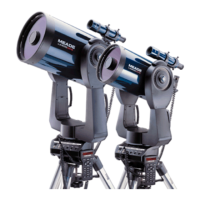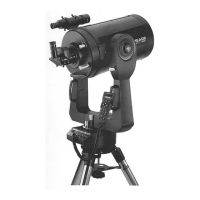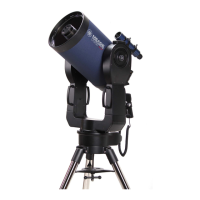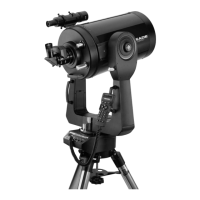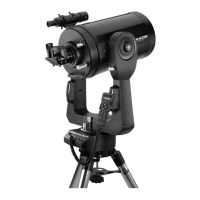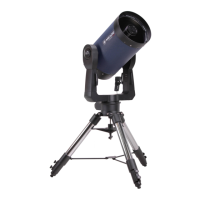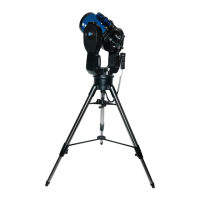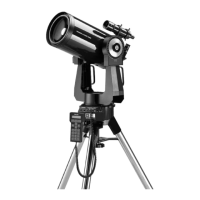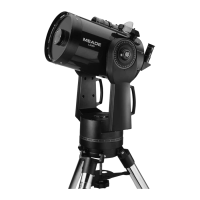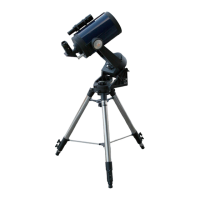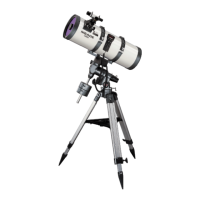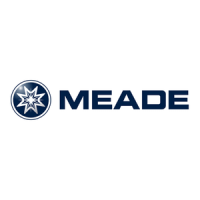Do you have a question about the Meade LX200GPS and is the answer not in the manual?
Lists the components included with the LX200GPS telescope and its accessories.
Provides step-by-step instructions for assembling the tripod and attaching the telescope.
Details the process of assembling the telescope, including battery installation and connecting the handbox.
Explains how to manually point and focus the telescope using its slow-motion controls.
Discusses the use of the telescope for terrestrial viewing and factors affecting image quality.
Guides users on how to move the telescope using the Autostar II hand controller's arrow keys.
Details the procedure for achieving precise focus using the microfocuser for sharp images.
Explains the different speed settings available for moving the telescope with the Autostar II.
Demonstrates how to navigate through Autostar II menus to perform common tasks like calculating sunset time.
Describes how to access and select astronomical objects from various libraries within the Autostar II system.
Explains how to access astronomical event data like sunrise, sunset, moon phases, and meteor showers.
Details the functions available in the Utilities menu, such as timers, alarms, and eyepiece calculations.
Covers various configuration options for the telescope, including date, time, and alignment settings.
Explains direct access to functions like focus control and reticle intensity using dedicated number keys.
Guides users on how to store and manage different observing locations within the Autostar II database.
Explains how to manually enter and store coordinates for celestial objects not found in the built-in libraries.
Provides instructions for tracking and observing satellite passes using the telescope.
Describes the essential first step to prepare Autostar II for telescope alignment procedures.
Details the automated two-star alignment process for setting up the telescope for accurate pointing.
Explains how to perform a manual two-star alignment using known bright stars for telescope setup.
Explains how to train the telescope's drive system to correct for periodic errors for precise tracking.
Provides detailed steps for aligning the telescope's optical components for optimal performance.
Lists the technical specifications for the Autostar II system, including processors and memory.
Details the physical and functional specifications of the Autostar II handbox controller.
Explains the principles and process of orienting the telescope's axis with the celestial pole.
Introduces the celestial coordinate system (RA and Dec) used for locating objects in the sky.
Describes the function and use of setting circles for manually locating celestial objects.
Discusses the use of an equatorial wedge for polar alignment and long-exposure astrophotography.
Explains the two modes (Automatic and Interactive) for presenting custom guided tours of celestial objects.
Highlights features specific to the 16-inch LX200GPS model, distinguishing it from other models.
Describes specific control panel features unique to the 16" LX200GPS model.
Provides cautions and procedures related to the commercial shipping and handling of the 16" LX200GPS.
Details features exclusive to the 14-inch LX200GPS model, such as battery compartments and auxiliary jacks.
Explains the location and use of the battery compartments specific to the 14" LX200GPS model.
Notes the inclusion of a 2" diagonal mirror with a 1.25" adapter with the 14" LX200GPS.
Refers to the assembly procedure for the optical tube assembly of the 14" LX200GPS.
Highlights the presence of auxiliary jacks on the left fork arm of the 14" LX200GPS for convenience.
Details the specific collimation procedure for the 14" LX200GPS, noting minor differences from other models.
Provides instructions for correctly assembling the microfocuser with a de-rotater accessory.
Introduces the Smart Mount feature and its purpose in improving telescope pointing accuracy.
Outlines the steps for training the Smart Mount system to correct for systematic pointing errors.
Explains how to access and use the Glossary feature for astronomical terms within Autostar II.
Provides descriptions of various astronomical objects like the Moon, planets, nebulae, and galaxies.
Lists the components included with the LX200GPS telescope and its accessories.
Provides step-by-step instructions for assembling the tripod and attaching the telescope.
Details the process of assembling the telescope, including battery installation and connecting the handbox.
Explains how to manually point and focus the telescope using its slow-motion controls.
Discusses the use of the telescope for terrestrial viewing and factors affecting image quality.
Guides users on how to move the telescope using the Autostar II hand controller's arrow keys.
Details the procedure for achieving precise focus using the microfocuser for sharp images.
Explains the different speed settings available for moving the telescope with the Autostar II.
Demonstrates how to navigate through Autostar II menus to perform common tasks like calculating sunset time.
Describes how to access and select astronomical objects from various libraries within the Autostar II system.
Explains how to access astronomical event data like sunrise, sunset, moon phases, and meteor showers.
Details the functions available in the Utilities menu, such as timers, alarms, and eyepiece calculations.
Covers various configuration options for the telescope, including date, time, and alignment settings.
Explains direct access to functions like focus control and reticle intensity using dedicated number keys.
Guides users on how to store and manage different observing locations within the Autostar II database.
Explains how to manually enter and store coordinates for celestial objects not found in the built-in libraries.
Provides instructions for tracking and observing satellite passes using the telescope.
Describes the essential first step to prepare Autostar II for telescope alignment procedures.
Details the automated two-star alignment process for setting up the telescope for accurate pointing.
Explains how to perform a manual two-star alignment using known bright stars for telescope setup.
Explains how to train the telescope's drive system to correct for periodic errors for precise tracking.
Provides detailed steps for aligning the telescope's optical components for optimal performance.
Lists the technical specifications for the Autostar II system, including processors and memory.
Details the physical and functional specifications of the Autostar II handbox controller.
Explains the principles and process of orienting the telescope's axis with the celestial pole.
Introduces the celestial coordinate system (RA and Dec) used for locating objects in the sky.
Describes the function and use of setting circles for manually locating celestial objects.
Discusses the use of an equatorial wedge for polar alignment and long-exposure astrophotography.
Explains the two modes (Automatic and Interactive) for presenting custom guided tours of celestial objects.
Highlights features specific to the 16-inch LX200GPS model, distinguishing it from other models.
Describes specific control panel features unique to the 16" LX200GPS model.
Provides cautions and procedures related to the commercial shipping and handling of the 16" LX200GPS.
Details features exclusive to the 14-inch LX200GPS model, such as battery compartments and auxiliary jacks.
Explains the location and use of the battery compartments specific to the 14" LX200GPS model.
Notes the inclusion of a 2" diagonal mirror with a 1.25" adapter with the 14" LX200GPS.
Refers to the assembly procedure for the optical tube assembly of the 14" LX200GPS.
Highlights the presence of auxiliary jacks on the left fork arm of the 14" LX200GPS for convenience.
Details the specific collimation procedure for the 14" LX200GPS, noting minor differences from other models.
Provides instructions for correctly assembling the microfocuser with a de-rotater accessory.
Introduces the Smart Mount feature and its purpose in improving telescope pointing accuracy.
Outlines the steps for training the Smart Mount system to correct for systematic pointing errors.
Explains how to access and use the Glossary feature for astronomical terms within Autostar II.
Provides descriptions of various astronomical objects like the Moon, planets, nebulae, and galaxies.
